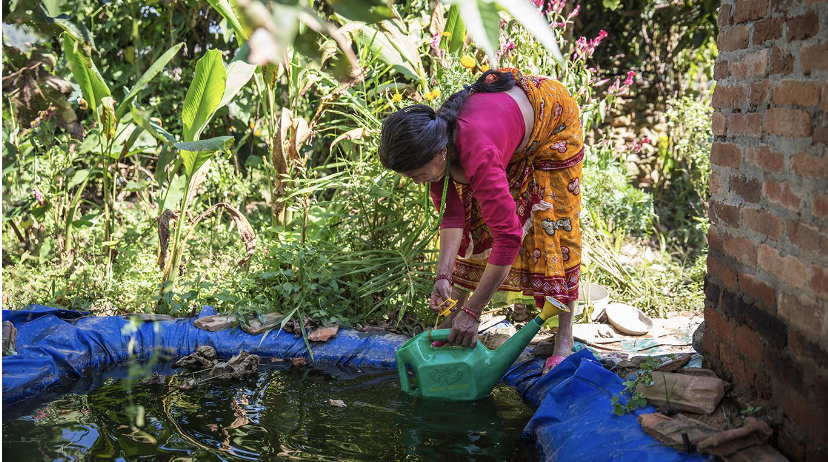Adapting to dry spells with low-cost ponds in Nepal

Summary
Nepal’s Kavre district has been hit hard by climate change and changing rainfall patterns. Changes in rainfall patterns, mainly due to climate change, have caused excess rainfall during monsoons and frequent dry spells for the rest of the year.Over two-thirds of the district’s population depend on agriculture and rely on rainfall for irrigation. A vulnerability assessment study was carried out in three Village Development Committees (VDCs) of Kavre, which revealed that drought and water stress are major challenges faced by farming communities in the district. To address this issue, the mid-hill farmers of Kavre need simple and affordable practices for efficient water management, such as cheap and easy-to-build plastic-lined ponds.
Overview
- Location:
- Implementation sites:
- Single country
- Multiple locations
- Mountain region:
- Hindu Kush Himalaya
- Province:
- Kavre
- Solution scale:
- Ecosystem type(s):
- Solution type(s):
- Sector(s):
- Climate impact(s) addressed:
- Impact time-scales:
- Co-benefits:
- Implementation timeline:
- 2023 - 2023
- Sendai targets:
Solution details
Main beneficiaries & outcomes
Japan’s Kochi University of Technology conducted a survey of over 1,000 farmers in Nepal’s western mid-hill agro-ecological zone. It revealed that vegetable production and income could increase more than 30 per cent by simply deploying water-conservation techniques such as water storage ponds.
With these plastic-lined ponds and other simple water management practices, such as drip irrigation, farmers have been able to use and manage available water more efficiently. This is particularly important in the face of climate change, where rainfall is becoming more erratic and unreliable and thus having negative impacts on farming and crop yields. By adapting to these changes, farmers will have more income security, further benefitting their own livelihoods and those of the local community.
Planning and implementation
In partnership with the Centre for Environment and Agricultural Policy Research, Extension, and Development (CEAPRED), farmers were encouraged to dig small ponds close to their house lined with plastic sheeting, allowing them to store household wastewater and rainwater. The plastic lining prevents the water from seeping into the ground. To avoid water losses due to evaporation, farmers were encouraged to locate the ponds under the shade of trees. The collected water can then be used to irrigate home or kitchen gardens during the dry season and during times of drought. In areas with clayey soil, the ponds were not required to be lined with plastic since the clay would retain water naturally.
Most farmers constructed a plastic pond (7 ft. x 4 ft. x 75 cm depth) with a capacity of 2,000 litres. Large community-managed plastic ponds (18 ft. x 24 ft. x 1 m depth) with a capacity of 16,000 litres were also constructed. Large plastic ponds collected wastewater from community drinking water taps, small streams and other water sources. The low-cost water storage pond and community ponds were first piloted in three Village Development Committees of Kavre. The ponds were later implemented in four additional sites in Panchkhal Municipality in Kavre.
The water-storage plastic ponds are affordable for farmers as they require no further investment other than the purchase of plastic sheets and can be built easily. Because of its simplicity and affordability, more farmers are willing to adopt this method and are likely to share their learning and knowledge with other farmers.

Finance
To add.
Innovation
To add.
Outlook & Scalability
Potential for upscaling and replication
Similar water-smart technologies that use a combination of science and local knowledge with low investment and minimal external technical support have also been promoted in eastern Nepal. The Government of Nepal has further ensured the upscaling of these low-cost water-smart technologies as resilient mountain solutions across 14 other districts in Nepal. Furthermore, the partner organizations are planning to introduce this technology to other regional member countries of the Hindu Kush Himalaya.



(0) Comments
There is no content